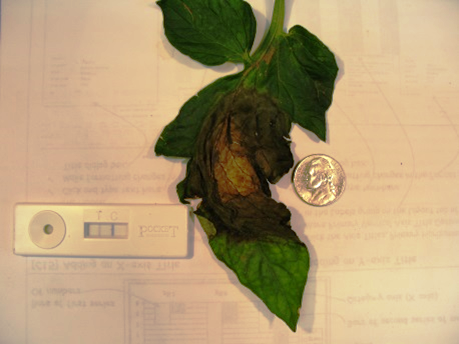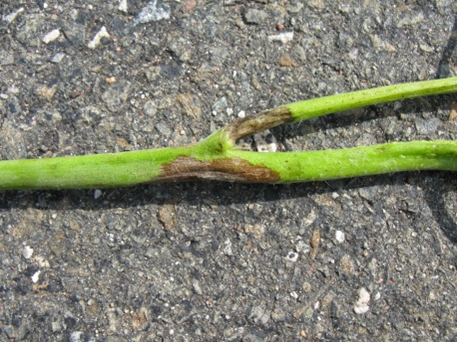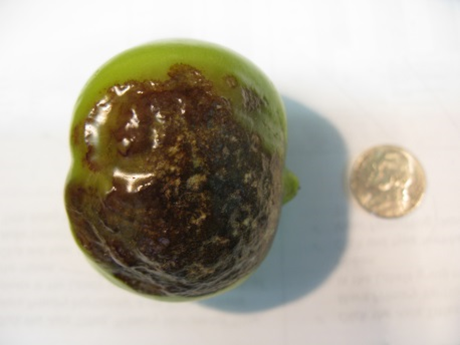By Jude Boucher, UConn Extension Educator, Commercial Vegetable Crops
Recap of 2012 Outbreak in CT
During the week of June 20, 2012, a Prospect, CT homeowner brought late blight (LB) infected tomato plants to the CT Ag Experiment Station diagnostic center. The homeowner had purchased the plants from a local supermarket, but when contacted, the supermarket management did not provide the source of the infected plants. Since LB is not listed as a restricted pest in CT, the state has no authority to force a vendor to stop selling infected plants or to reveal where they purchased infected plants, so that a future epidemic might be avoided by cleaning up the problem at the source. We could only assume that there were plenty of gardens with infected tomato plants around Prospect.
Late blight lesions on tomato leaf. Photo by Joan Allen, UConn diagnostician.
I recommended that all organic farms begin to apply preventative applications of copper, and all conventional farms start their early blight fungicide program to stop low levels of LB spores. Late blight spread is usually favored by cool temperatures and frequent precipitation, and July was the warmest month on record and completely dry through most of the state for the first three weeks. However, LB can spread when relative humidity nears 100%.
On July 13, two organic farms reported outbreaks of LB in both the eastern and western portions of the state. It was recommended that these farmers destroy their infected field tomatoes and potatoes to help prevent further spread of the disease and to save high tunnel tomatoes at these sites from becoming infected. I also recommended that all conventional farms begin preventative applications of the stronger, mobile, late blight-specific fungicides on their tomato and potato crops. By late July many more organic farms that did not use copper reported LB outbreaks, and by late August most organic farms had infected tomatoes and potatoes. In early September with more rain and cooler temperatures, conventional farms that had not switched to the stronger LB fungicides began reporting crop losses. There were even a few farms using the stronger fungicides that reported finding LB, but as far as I know, the fungicides prevented extensive crop loss in all cases. Many growers’ crops survived the 2013 outbreak, but again at great expense. So what can you do to stop the disease in 2013?
What you need to know about late blight
Late blight lesions on tomato stem. Photo by Joan Allen, UConn diagnostician.
Late blight (Phytophthora infestans) is a water mold that can cause complete loss of potato and tomato crops in as little as 7 to 10 days after infection. This disease caused extensive crop losses in Europe during the mid-1800s, including the Irish Potato Famine. It is closely related to Phytophthora blight (P. capsici), which is so destructive to solanaceous, cucurbit and leguminous plants, and infests soils on farms for decades, even in the absence of a host. Unlike Phytophthora blight, LB doesn’t form long-term resting spores (oospores) in our area, so it doesn’t overwinter in the soil. That’s the good news! However, there are places in the world, such as Scandinavia, Mexico and South America, where the two “sexual” mating types have crossed or “mated” to produce a LB strain that does produce oospores, and where late blight is an annual problem on infested farms. Cooperation between growers to help prevent LB outbreaks is crucial to prevent a scenario where both mating types occur in our region and become a permanent, annual problem. In short, the more years we have a state- or region-wide outbreak with our current strain(s) of LB, the higher the odds that the second mating type shows up and results in a sexual cross, oospores, and a permanent LB problem. Such a cross could also produce fungicide-resistant offspring.
The strain of LB that we have been experiencing in the northeast, spreads by producing sporangia (secondary spores), which are capable of moving 30 to 40 miles on the wind. However, Long Island Sound frequently acts as a barrier to protect CT farms from LB outbreaks on the island. So, typical spread of the disease may be more localized than what is indicated by the maximum range of spore flight, but may be influenced by large storm systems, such as Hurricane Irene or even prevailing wind direction.
Zoospores (that swim) are produced in the sporangia, and either the sporangia directly or the zoospores can penetrate the leaf surface and start the infection. Usually, a thin film of water is needed for the spores to penetrate the leaf cells, but as mentioned, even extreme humidity will provide enough water for infection to occur. The optimum temperature for infection is between 54 to 75 degrees, but during 1 to 2 days of extreme humidity, infection may take place at up to 86 degrees F. Cool August and September nights that produce heavy morning dews (i.e. 100% relative humidity) are perfect for LB infection.
Because spore deposition and leaf wetness time are limited in greenhouse and high tunnel conditions, tomato plants grown inside usually remain LB-free, unless there is a source of spores almost adjacent to the houses. However, due to high humidity in some tunnels and greenhouses, when infection does occur, it can cause rapid and extensive crop losses.
LB survives the winter on potato tubers or may arrive on infected tomato transplants in the spring (as it did in 2009). This disease organism requires living tissue, so tubers that have frozen near the soil surface will not allow the disease to survive. Growers should control volunteer potatoes that sprout from deep within the soil of the previous year’s potato patch or from cull plies to prevent the disease from surviving the winter. You should only plant certified disease-free potato seed stock. Never save your own seed stock from a previous year if LB was on the farm or use table stock for seed. LB will not survive in tomato seeds or on the dead residue of the previous tomato crop. If possible, always grow your own tomato transplants from seed to avoid LB problems in the greenhouse and field. Inspect all tomato transplants arriving on your farm for signs of LB, and reject, or bag and dispose of infected transplants.
Late blight lesions on tomato fruit. Photo by Joan Allen, UConn diagnostician.
Growers should inspect tomato and potato plantings weekly for signs of LB. Suspected incidences of LB infection should be confirmed by bringing a sample plant to a diagnostic lab at the CT Ag Experiment Station in New Haven or Windsor, or to the UConn lab in the Radcliff-Hicks Building in Storrs. If LB is confirmed, alert your local vegetable crops Extension Educator (yours truly) so that growers throughout the state and region can be alerted and respond to the LB threat. Tracking the outbreak back to the source of the first infected plants is also a crucial part of combating future outbreaks, so that we can help a grower clean up and eliminate the problem before they start an epidemic the following year too. All tomato and potato growers should call or access the UConn Vegetable IPM Pest Message (860-870-6954, http://ipm.uconn.edu) every Friday afternoon during the summer, to see if late blight has been found in CT and to catch up on current fungicide recommendations.
At the beginning of the outbreak, it is essential that the first few growers with infected plants destroy their crop to help prevent a full blown outbreak from occurring, starting with neighboring farms. Infected potato plantings can be plowed under, harrowed, flamed or burned down with a contact herbicide, such as diquat or paraquat. Trellised tomato plants should be cut at the base and at mid-trellis height to kill the plants and help remove the trellis twine. They should then be treated as described above. Spores are inactivated within hours when exposed to high levels of UV light, so plantings that are sporulating should be handled or tilled down on a sunny day to minimize the possibility of disease spread. Obviously, once several farms are involved in an outbreak, the need to destroy the crop diminishes, as it can be assumed that the spores are on the wind.
There are active LB resistant-tomato breeding programs at Cornell University and at some seed companies, but variety choices are still limited. ‘Mountain Magic’, ‘Plum Regal’, ‘Jasper’ (cherry) are recently listed resistant varieties, while other heirlooms such as ‘Mr. Stripy’ and ‘Striped German’ have held up well in recent outbreaks. For potatoes, some varieties have more tolerance, such as; ‘Elba’, ‘Kennebec’, ‘Allegany’, ‘Sebago’, ‘Rosa’, ‘Defender’, ‘Jacqueline Lee’ and ‘Ozette’.
Managing late blight with fungicides
Protectant fungicides are not mobile within the leaf or the vine and thus, often result in lower rates of coverage, and tend to be less effective than systemic or mobile fungicides registered for LB. Some of the protectant fungicides registered for late blight control on tomatoes and potatoes include; copper (i.e. Champ), chlorothalonil (i.e. Bravo), and mancozeb (i.e. Dithane). Protectant fungicides usually provide some degree of protection under light disease pressure (few spores in the air and weather conditions that do not favor LB infection).
Mobile fungicides (systemic and translaminar) result in better under leaf coverage and tend to be more effective against this disease. Some of the more effective products include; cyazofamid (i.e. Ranman), propamocarb (Previcur Flex), fluopicolide (i.e. Presidio), mandipropamid + difenoconazole (i.e. Revus Top), cymoxanil (i.e. Curzate), and cymoxanil + famoxadone (Tanos).
When designing your own fungicide program, you should be looking for products with short day-to-harvest (dh) restrictions so that you can harvest tomatoes as they ripen; a short re-entry interval (REI) so that you or your crew can work in the field when needed; and a product that can be applied several times during one season, so you don’t have to buy too many different fungicides. Because of long dh intervals, some products, such as Dithane and Previcur Flex will only be useful before tomato fruits color. Remember, that as part of your resistance management program with mobile fungicides you should always alternate between two different pesticide groups or families and mix each mobile fungicide with a protectant. The protectant fungicide will also provide control of other important diseases such as early blight and Septoria leaf spot. They should be applied on a 7 to 10 day interval. Here is a list of some of the LB products and important label considerations to help you design your spray schedule.
chlorothalonil (Bravo), 7dh, REI 12h, Group M5, should be limited to 50% of applications each season to prevent early blight resistance.
copper (Champ), 0dh, REI 24h, Group M1,
mancozeb (Dithane), 5dh, REI 24h, Group M3,
cyazofamid (Ranman), 0dh, REI 12h, Group 21, limit of 6 applications per season.
cymoxanil (Curzate), 3dh, REI 12h, Group 27, limit of 6 applications per season.
cymoxanil + famoxadone (Tanos), 3dh, REI 12h, Groups 27 & 11, limited to 50% of applications each season.
fluopicolide (Presidio), 2dh, REI 12h, Group 43, limit 3 to 4 applications per season, not registered for potatoes.
mandipropamid + difenoconazole (Revus Top), 1dh, REI 12h, Groups 3 & 40, limit of 4 to 5 applications per season.
propamocarb (Previcur Flex), 5dh, REI 12h, Group 28, limit of 6 applications per season
Much of the information in this article was consolidated from several LB fact sheets written by Meg McGrath and Tom Zitter at Cornell and Mary Hausbeck at Michigan State, as well as several other sources.


